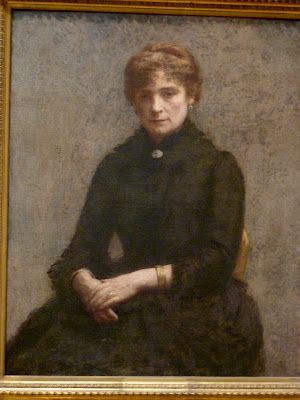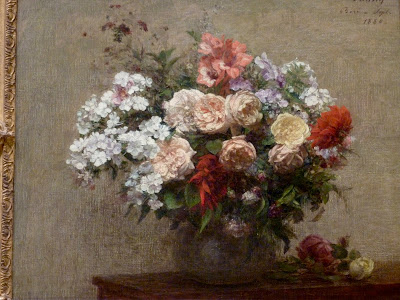Conservative and conventional as his work was, he had the respect and esteem of his more famous colleagues. Manet sat for a portrait by Fantin Latour while at the height of his scandalous successes at the Salon Exhibitions.
Fantin Latour is one of the great second string painters of the 19th century, an age full of great second bests. His work may not be as demanding as Cezanne's, but it's not hard to see why it earned such respect. It is beautifully painted, and an inexhaustible delight to look at.
The Met has a number of paintings by Fantin Latour which have only been on display recently, within the last few years. Since the demise of modernist orthodoxy, these paintings have been leaving the storage areas where they languished for decades to delight us again. Many pioneers of modern painting from that era would be pleased at the revival of his fame.
These are some of my photos of a few of Fantin Latour's paintings in the Met.
 A very beautiful example of what made him famous, flower pictures
A very beautiful example of what made him famous, flower pictures A detail of the same picture showing some marvelous passages of painting.
A detail of the same picture showing some marvelous passages of painting. A beautiful portrait of an unidentified woman from about 1885
A beautiful portrait of an unidentified woman from about 1885


And finally, one of my badly cropped photos of a still life of roses and other flowers.
A shout out to my old friend in Saint Louis, Thomas, who is a longtime fan of Fantin-Latour's work.
3 comments:
He's got a lovely use of light (Bite me, Thomas Kincaid!)
Kinkade doesn't hold a candle to Fantin Latour, so to speak.
Thanks for thinking of me, and letting me know. Dear Henri, an artist of very great limitations. It seems that he had no talent for action. Even his feel for space seems compromised when dealing with multiple figures. He did quite nicely with single figures, but much more of his best things are surely the little still-life and flower pictures with their glistening, nacreous light.
In these pictures it’s as though one has taken one’s attention away, for a moment, from some main scene, now elided and not visible, to a detail from the background, from the side, from back in the corner. I think that accounts for the slight feeling of ennui carried into the picture. And the sense of being-drawn-away to a thing behind -- that inner movement -- is a correlate to nostalgia; but the pieces are so beautifully wrought that they never cloy.
It’s gladdening to hear that Fantin-Latour’s works are no longer kept away from the public’s gaze. And how doubly apt, that something neglected and overlooked is able to get some attention!
Post a Comment